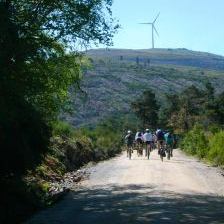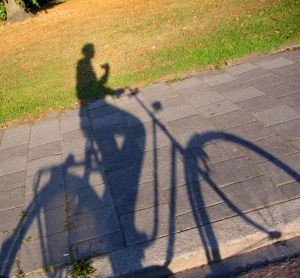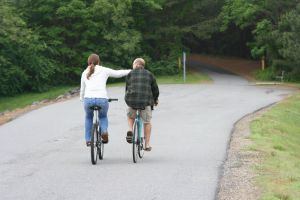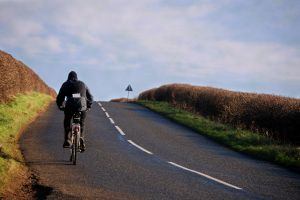 Despite a complicated relationship with bicycles, Charlotte Safavi ventured to the 13th stage ending of the Tour de France in Nimes, France last summer. As the bicyclists kicked off the 96th annual Tour de France on July 4, 2009, she recalls how she went from novice to enthusiastic sports spectator in a day at the races.
Despite a complicated relationship with bicycles, Charlotte Safavi ventured to the 13th stage ending of the Tour de France in Nimes, France last summer. As the bicyclists kicked off the 96th annual Tour de France on July 4, 2009, she recalls how she went from novice to enthusiastic sports spectator in a day at the races.
Before experiencing the Tour de France in Southern France last summer, my relationship with bicycling was tenuous at best. (I learned how to ride at seven … teen—and only out of necessity to get around campus!)
So naturally, I was less than enthusiastic when my husband announced that the Tour had a stage ending in Nimes near where we were vacationing.
The ominous-sounding 13th stage—one of 21 stages making up the 2,174-mile route that year—said it all.
But because Ron is a serious cyclist, with three bikes in the garage, a subscription to something called Pedal Patter, and a drawer full of spandex, I say, “Great! Let’s go.”
 We begin our day at the races at 8 a.m. Although the contestants are somewhere west of us and are not due in town until mid-afternoon, getting there well before them is important to ensuring a good spot for viewing the arrival.
We begin our day at the races at 8 a.m. Although the contestants are somewhere west of us and are not due in town until mid-afternoon, getting there well before them is important to ensuring a good spot for viewing the arrival.
“I want to ride my bicycle,” I sing from Queen’s song Bicycle Race, as we drive to Nimes.
“Mom, please,” pleads my 8-year-old son R.J. OK, it is too early for Freddie Mercury, though the Tour allegedly inspired Queen’s hit single when the peloton (main group of bicyclists) breezed by his Riviera hotel in 1978.
I learn the Tour is much older than that. The first of the multi-staged races took place in 1903 to promote a sports paper ironically called L’Auto. In the early days, anyone could compete, each stage a one-day race, the overall winner completing all the stages in the shortest time.
Things were rougher then. Entrants had cumbersome bikes, carried spares around their necks, dangled tools from their handlebars. They were not svelte athletes in space-age helmets on sleek, multi-geared bikes with wheels as thin as ham slices.
 But the Tour spirit stays the same. The modern version is a three-week stage race covering around 2,200 miles of mixed terrain strung like a necklace mostly across France. The route changes annually. Entry is by invitation and there are 20 or so sponsored teams of nine cyclists. Special jerseys identify riders with specific skills, like the “red polka dot” for the King of the Mountains, bestowed upon the best climber in a bicycle race.
But the Tour spirit stays the same. The modern version is a three-week stage race covering around 2,200 miles of mixed terrain strung like a necklace mostly across France. The route changes annually. Entry is by invitation and there are 20 or so sponsored teams of nine cyclists. Special jerseys identify riders with specific skills, like the “red polka dot” for the King of the Mountains, bestowed upon the best climber in a bicycle race.
The town of Nimes, where we are viewing the end of the 13th stage lies in the middle of the first Roman road built in Gaul connecting Italy and Spain. Nimes’ centre de ville remains rife with Roman architecture.
We pass La Maison Carree, a columned ancient temple, and I take note of the nearby modern Carree D’Art Musee in case I need a break from my boys—and from the bikes.
The Tour arrival is on the broad Avenue Jean Jaures lined in makeshift barricades advertising sponsors. At the northernmost end, the Tour Magne, a Roman watchtower on a hill, overlooks the route.
For more slices of life in France, don’t miss Suzy Gershman’s Postcard from Provence, France. There’s also Suzy Gershman’s Postcard from Paris.
A worker in a cherry picker trims plane trees near the finish line; austere French Red Cross officials pull up in an equipped van; and a newscaster sporting a five o’clock shadow drags on a cigarette and slugs a beer beside a row of parked Skoda cars, the official Tour car.
Police officers mull about, keeping an eye on amateurs riding their bikes along the route, as is permitted, before the pros arrive.
 An irresistible sense of festivity builds as spectators show up, a cross section of French society—and tourists like us. Though the Tour is an international event, it is clearly a source of national pride.
An irresistible sense of festivity builds as spectators show up, a cross section of French society—and tourists like us. Though the Tour is an international event, it is clearly a source of national pride.
“Hot dogs!” says R.J., staring at succulent saucissons de Toulouse on a grill outside a restaurant where additional sidewalk seating is set up for the event. My own eyes stop at an enormous pan of paella, chock full of seafood, chicken and sausage atop saffron-spiced rice the color of sunset.
I ask, “Why paella?” The young chef tending the dish and sporting a bull graphic on his T-shirt says he trained in Spain.
Our waiter reminds us we are in France when he hands us rose wine in plastic goblets at the picnic table where we sit. “Pour les fetes,” he says disdainfully of the receptacles. As we eat, I catch myself checking updates on the tickertape next to the finish line.
If you’re a foodie, too, check out Voyage de Fromage: Destinations for Cheese-Lovers.
After lunch, we stake out a prime shaded spot from which to view the race. A vast overhead flat-screen pulses with live images accompanied by animated commentary.
The Tour has its own jargon, with verbs like attacquer—to break away aggressively from other riders; adjectives like rouleur describing a rider with smooth pedaling action; and nouns like voiture balai, translated as “broom wagon” for sweeping impaired riders out of the way!
 I escape for a quick spin around the Carree D’Art. The museum is full of captivating contemporary art, but I quickly realize that I am anxious to get back to the action.
I escape for a quick spin around the Carree D’Art. The museum is full of captivating contemporary art, but I quickly realize that I am anxious to get back to the action.
After I rejoin my family, the caravane publicitaire gets underway, whereby sponsors in customized vehicles toss freebies to the crowd, including much-needed bottled water.
Music blares. People wave and cheer. The parade is a diminutive yet blatantly commercial version of Mardi Gras in New Orleans. A car fashioned to resemble an oversized cup of Nestlé instant coffee cruises by, bracketed by other vehicular novelties advertising everything from soap detergent to national banks. By the end of the cavalcade, my son has caught more stuff than he knows what to do with.
Interested in more interesting ways to explore Europe? Why not a barge trip? Check out Barging Through Europe.
An anticipatory lull sets in. People around us check the TV monitor for updates, consult their neighbors in hushed tones, or simply crane their necks southward. Parents lift toddlers onto their shoulders. Latecomers jostle in.
 Like a wave, a cheer travels from far to near along the barricade, and all of a sudden, the peloton breaks through. They zip by with astounding speed, like fleeing game, but also with poetic motion. The spectators are cheering loudly now—and so am I—but mostly I am entranced by the fleeting yet wondrous sight of athletes gracefully flying by at the end of a grueling ride. In seconds, the race is over but for stragglers who also get encouragement from the crowd.
Like a wave, a cheer travels from far to near along the barricade, and all of a sudden, the peloton breaks through. They zip by with astounding speed, like fleeing game, but also with poetic motion. The spectators are cheering loudly now—and so am I—but mostly I am entranced by the fleeting yet wondrous sight of athletes gracefully flying by at the end of a grueling ride. In seconds, the race is over but for stragglers who also get encouragement from the crowd.
The best part about the Tour is the parts are bigger than the sum. As we head back to our car near Porte Auguste, the remains of a city gate crowned by a statue of Augustus, I feel the same way about our day at the races. The end of the propitious 13th stage of the Tour de France simply capped hours of fun and entertainment.
For more information on active vacations, check out Adventure & Sports Travel.
Now in 2009, Lance Armstrong, record holder for most consecutive Tour wins, is back in the saddle. I, for one, want to be there—if only for a stage.
Lessons learned from a day at the races:
- Though a stage is viewable along its route, pick the arrival or departure location for the fullest experience.
- Get there early to secure a good spot for watching the race.
- If driving, check road closures to park for an easy exit.
- Pick up additional Tour information at the local Bureau de Tourisme.
- Wear sunscreen (especially at high altitudes.)
- Bring water and snacks.
- Either make advance reservations for lunch—or be flexible.
- If traveling with kids, carry things to amuse them during the wait.
- Buy merchandise late, as some items will be discounted.
For more information, visit www.letour.fr.
By Charlotte Safavi for PeterGreenberg.com. Charlotte Safavi is a freelance journalist based in the Washington, DC area. She has written for several publications, including The Washington Post and The Sunday Times Travel Magazine, and she blogs for The Huffington Post. Visit Charlotte on the Web at www.charlottesafavi.com, and follow her on Twitter.com/charlottesafavi.












